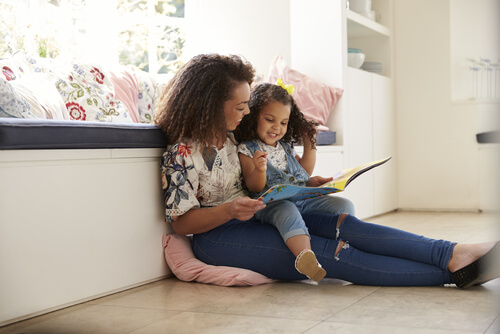10 Top Tips for At-Home Speech Practice
Jan 15, 2022 Speech development involves learning how and where to move the mouth, while directing airflow from the lungs to the right places to make clear and accurate sounds for words.
As such, this can be a tricky process to communicate to our children! That’s why the best way is to model/show our children and let them hear the sound over and over again. Many of us are at home at the moment, so it’s a great opportunity to play, talk, and do speech therapy homework! This is a great how-to practice speech therapy at home source!
All children develop speech in pretty much the same way, with early sounds like p, b, m, n, t, and d coming first, and more mature sounds like s, ch, r, sh appearing later on. At first, as our children learn word sounds they often make mistakes: for example, their “g” sound might sound more like a “d,” so when they say ‘pig’ it sounds like ‘pid.’ Or their ‘c’ might sound more like a ‘t,’ so they say ‘tat’ instead of ‘cat.’
These mistakes happen and are completely OK while they are learning and practicing these sounds. There are ways we can support our children in learning, practicing, and perfecting these sounds at home in our everyday routine and play.
Some children find it difficult to perfect these sounds on their own. They continue to be hard to understand beyond their early years. If you feel like your child is struggling to make themselves understood to others, you should always contact your local Speech and Language therapy unit to discuss your child’s development.
For most children, however, their speech sounds just need a little time, a little support, and a lot of fun to get them going. Have a look below at the 10 Top Tips that you can use to support your child’s speech sounds. The Speech Blubs app also has a great range of sound activities you can do with your little one.

10 Top Tips for At-Home Speech Therapy Practice
Focus on target sounds for rapid speech and language development.
1. It’s never too early to start.
From day one, your baby is listening and looking at your face. Making sounds that your baby can look at and listen to is fun, interactive, and great for their early communication skills.
2. Different sounds are perfected at different ages.
We would not expect a 2-year-old to be able to produce a beautiful “sh” or perfect “th.” Nor would we expect a 4-year-old to always manage multi-syllable words with consonant clusters like “st” “thr” “pl,” etc. Many of your child’s errors could well be age-appropriate. This is important to bear in mind, as we want to support and model appropriate sounds for your child’s age that are within their ability to achieve.
Have a look at the list below to get an idea of where you could start . . . (Norms taken from – Speech Sounds, Goldman-Fristoe Test of Articulation 2 (GFTA-2) (2000)):
2 yrs. – /b/ /h/ /d/ /m/ /n/ /p/
3 yrs. – /f/ /g/ /t/ /k/ /w/ /ng/
4-5 yrs. – /ch/ /j/ /l/ /s/ /ch/ /bl/ /j/ /r/
6 yrs. – /v/ /br/ /dr/ /fl/ /fr/ /gl/ /gr/ /kl/ /kr/ /pl/ /st/ /tr/
7 yrs. – /z/ /sl/ /sp/ /sw/ /th/
Boost Your Child’s Speech Development!
Improve language & communication skills with fun learning!

3. Hearing and seeing.
The best way for a child to learn or perfect a sound is by hearing it and seeing it over and over again. Avoid asking your child to say the sound. Instead show them. They will automatically repeat and practice in time. Get face-to-face and at eye level with your child to help them see your model. Turn off background noise to help them hear your model.
4. Practice during play.
Just like us, our kids much prefer to do things if they are fun and motivating! The great thing is, speech can be practiced during play. When they are playing with their toys or taking part in an activity, just add the sounds to the action . . . for example, if they are pushing cars . . . add “mmmmmm” to their driving, “ssssss” to filling up with petrol, “k-k-k-k” to the crane lifting. If they are playing with dolls . . . add “sssshhh” when washing hair, “t-t-t” when they walk, and add “zzzz” when they go to sleep.
5. Practice every day.
Sometimes getting down on the floor and doing 1:1 play with our child is something we want to do, but for which we don’t always have the time. Don’t worry. Instead, add sound play to the things in your daily routine, for example, repeat a ‘p’ sound on each step when walking up the stairs, model ‘sh’ when pouring water in the bath, model ‘k’ when chopping up their dinner, or model ‘z’ when brushing their teeth.
6. Where does the sound occur in the word?
When playing with sounds, think about the sounds at the start of a word, but also the sounds in the middle, and at the end. For example, if you are working on ‘t,’ model it at the start “tea,” in the middle “water,” and at the end “cat.”
7. Start with single sounds.
Start by modeling the sound on its own. Just like when a baby starts repeating single sounds when they babble, do the same by modeling the sound on its own, for example, “g – g – g.” Let them see your mouth, the shape of your lips, and the position of your tongue. All of these help your child improve the accuracy of their production.
8. Work on single words.
Move on to modelling the sound in single words, when you name things in the world around your child. This allows the child to hear the sound clearly, for example: goat, goal, and game.
9. Try simple sentences.
Boost the difficulty by creating simple, clear sentences and modeling the words. Looking at books is a great way to help your child use their new sound in sentences. Use short sentences to describe things in the pictures, e.g. “the dog is walking,” or “the baby is crying.”

10. When in doubt . . . guess!
If your child speaks but you don’t understand, guess what they have said and say it back to them. First, this lets him/her know that you are listening; secondly, you may guess right and so your child will feel successful; thirdly, it’s an opportunity for your child to hear clear and accurate pronunciation.
Speech sound development and language skills can be a long process, and will likely take weeks and maybe even months to see progress. If you have any questions, ask your local speech therapist for help with speech therapy at home. But keep your speech homework fun and simple, and keep going to get super speech started!
Also, check out our blog “Articulation Therapy: An All-in-One Guide for Parents” for more tips and tricks to practice speech at home.
